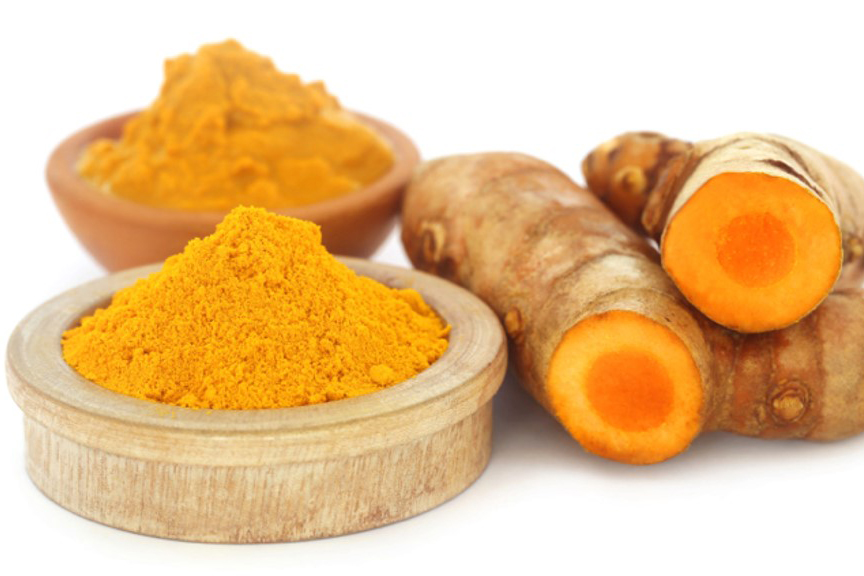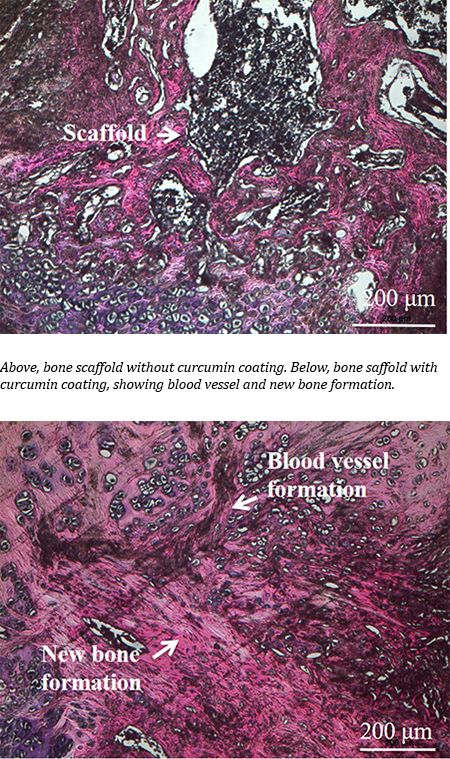Curcumin is a constituent of turmeric (used in cooking and as a remedy in Ayurvedic medicine). It’s been a while since I’ve stumbled across a curcumin story (scientists have been trying to find a way to exploit its therapeutic qualities for years). The latest news comes from Australia, which is a little unexpected as most of the ‘curcumin research stories’ previously on this blog have come from India.
A March 5, 2020 news item on ScienceDaily announces new research on curcumin therapeutic possibilities,
For years, curry lovers have sworn by the anti-inflammatory properties of turmeric, but its active compound, curcumin, has long frustrated scientists hoping to validate these claims with clinical studies.
The failure of the body to easily absorb curcumin has been a thorn in the side of medical researchers seeking scientific proof that curcumin can successfully treat cancer, heart disease, Alzheimer’s and many other chronic health conditions.
Now, researchers from the University of South Australia (UniSA), McMaster University in Canada and Texas A&M University have shown that curcumin can be delivered effectively into human cells via tiny nanoparticles.
Over three years ago on December 2, 2016, researchers from McMaster University made this video about Alzheimer’s and curcumin research available,
From the McMaster University, Centre for Health Economics & Policy Analysis, December 2, 2016 news webpage,
This video investigates the therapeutic potential of curcumin, a substance found in turmeric, to prevent Alzheimer’s disease. The information presented in this video has integrated research including in vitro studies that aimed to observe the influence of curcumin based interventions in the neuropathology of Alzheimer’s disease. From mechanisms for neurogenesis to the disintegration of beta amyloid plaques, this video highlights that there are many pathways by which curcumin can elicit its effects. However, there are currently not enough human trials to support the mouse-model studies for turmeric’s ability to prevent Alzheimer’s.
Back to the latest work, a March 5, 2020 UniSA press release (also on EurekAlert), which originated the news item, describes curcumin research that focuses on STI’s (sexually transmitted infections), also mentioned is earlier work on Alzheimer’s Disease,
Sanjay Garg, a professor of pharmaceutical science at UniSA, and his colleague Dr Ankit Parikh are part of an international team that has developed a nano formulation which changes curcumin’s behaviour to increase its oral bioavailability by 117 per cent.
The researchers have shown in animal experiments that nanoparticles containing curcumin not only prevents cognitive deterioration but also reverses the damage. This finding paves the way for clinical development trials for Alzheimer’s.
Co-author Professor Xin-Fu Zhou, a UniSA neuroscientist, says the new formulation offers a potential solution for Alzheimer’s disease.
“Curcumin is a compound that suppresses oxidative stress and inflammation, both key pathological factors for Alzheimer’s, and it also helps remove amyloid plaques, small fragments of protein that clump together in the brains of Alzheimer disease patients,” Prof Zhou says.
The same delivery method is now being tested to show that curcumin can also prevent the spread of genital herpes.
“To treat genital herpes (HSV-2) you need a form of curcumin that is better absorbed, which is why it needs to be encapsulated in a nano formulation,” Prof Garg says.
“Curcumin can stop the genital herpes virus, it helps in reducing the inflammation and makes it less susceptible to HIV and other STIs,” Prof Garg says.
Women are biologically more vulnerable to genital herpes as bacterial and viral infections in the female genital tract (FGT) impair the mucosal barrier. Curcumin, however, can minimize genital inflammation and control against HSV-2 infection, which would assist in the prevention of HIV infection in the FGT.
Here’s a link to and a citation for the latest paper,
Curcumin Can Decrease Tissue Inflammation and the Severity of HSV-2 Infection in the Female Reproductive Mucosa by Danielle Vitali, Puja Bagri, Jocelyn M. Wessels, Meenakshi Arora, Raghu Ganugula, Ankit Parikh, Talveer Mandur, Allison Felker, Sanjay Garg, M.N.V. Ravi Kumar, and Charu Kaushic. Int. J. Mol. Sci. 2020, 21(1), 337; DOI: https://doi.org/10.3390/ijms21010337 Published: 4 January 2020
This is an open access paper and is part of the journal’s Special Issue Curcumin in Health and Disease: New Knowledge)
For anyone interested in the earlier work on Alzheimer’s Disease, here are links to two papers that were published in 2018 by a team led by Sanjay Garg,
Curcumin-loaded self-nanomicellizing solid dispersion system: part I: development, optimization, characterization, and oral bioavailability by Ankit Parikh, Krishna Kathawala, Yunmei Song, Xin-Fu Zhou & Sanjay Garg. Drug Delivery and Translational Research volume 8, pages 1389–1405 (2018) DOI: https://doi.org/10.1007/s13346-018-0543-3 Issue Date: October 2018
Curcumin-loaded self-nanomicellizing solid dispersion system: part II: in vivo safety and efficacy assessment against behavior deficit in Alzheimer disease by Ankit Parikh, Krishna Kathawala, Jintao Li, Chi Chen, Zhengnan Shan, Xia Cao, Xin-Fu Zhou & Sanjay Garg. Drug Delivery and Translational Research volume 8, pages 1406–1420 (2018) DOI: https://doi.org/10.1007/s13346-018-0570-0 Issue Date: October 2018
Neither of these paper is open access but you can gain access by contacting sanjay.garg@unisa.edu.au
This looks like exciting work, bearing in mind the latest curcumin research on an STI was performed on female mice. As for the Alzheimer’s papers, that curcumin research was also performed on animals, presumably mice. As the press release noted, “This finding paves the way for clinical development trials for Alzheimer’s.” Oddly, there’s no mention of clinical trials for STI’s.


